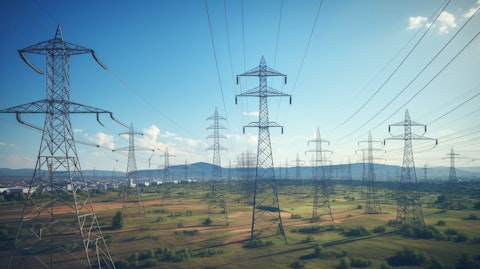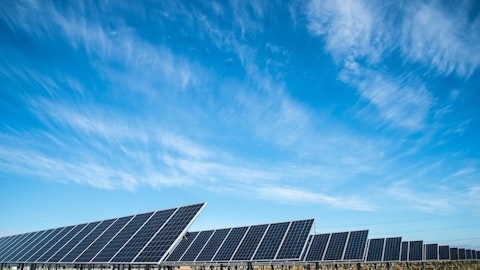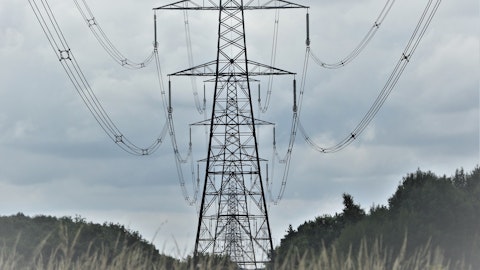PNM Resources, Inc. (NYSE:PNM) Q3 2023 Earnings Call Transcript October 27, 2023
PNM Resources, Inc. misses on earnings expectations. Reported EPS is $ EPS, expectations were $1.3.
Operator: Good day and welcome to the PNM Resources’ Third Quarter 2023 Conference Call. All participants will be in listen-only mode. [Operator Instructions] Please note this event is being recorded. I would now like to turn the conference over to Lisa Goodman, Investor Relations. Please go ahead.
Lisa Goodman: Thank you, Dave and thank you everyone for joining us this morning for the PNM Resources’ third quarter 2023 earnings call. Please note that the presentation for this conference call and other supporting documents are available on our website at pnmresources.com. Joining me today are PNM Resources’ Chairman and CEO, Pat Vincent-Collawn; President and Chief Operating Officer, Don Terry; and Senior Vice President, Chief Financial Officer and Treasurer, Lisa Eden. Before I turn the call over to Pat, I need to remind you that some of the information provided this morning should be considered forward-looking statements pursuant to the Private Securities Litigation Reform Act of 1995. We caution you that all of the forward-looking statements are based upon current expectations and estimates and that PNM Resources assumes no obligation to update this information.
For a detailed discussion of factors affecting PNM Resources’ results, please refer to our current and future annual reports on Form 10-K, quarterly reports on Form 10-Q as well as reports on Form 8-K filed with the SEC. With that, I will turn the call over to Pat.
Pat Vincent-Collawn: Thank you, Lisa. Good morning everyone and thank you for joining us today on Cranky Coworkers Day and yes, you can Google it, it is a real day. Now, we are sure none of you have any cranky coworkers or that none of you are 1 of those cranky coworkers and none of us surely are, but we’re going to celebrate the day just in case. I’m going to start on Slide 4 with our financial results and strategic updates. Ongoing earnings were $1.54 for the third quarter compared to $1.46 last year. Summer temperatures were hotter across New Mexico and Texas and had a significant impact on earnings. We are adjusting our guidance for the year to a range of $2.75 to $2.80 per share. Lisa will walk through the details. The New Mexico Supreme Court held oral arguments on our merger with AVANGRID on September 15th, this was the final step in the appeal process, and there is no timeline for when the court will issue its decision.
And yes, we were priced compete because we agree that the waiting is the hardest part. As a reminder, the court has two options: to uphold the Commission’s decision or to vacate the order and remand the case back to the Commission. If there is a remand, the Commission will determine the next steps on how to respond to the court’s order. The merger agreement was previously extended through December with the option for a further three-month extension through March. Separately, the sale of our joint venture, NMRD remains on track. The renewable projects in this portfolio are attractive assets even in the current challenging market, and we are working to evaluate the bids. We expect to close the sale in the late fourth quarter or early first quarter.
With that, I’ll turn it over to Don.
Don Tarry: Thank you, Pat and good morning, everyone. I’ll start on Slide 6 with operational highlights at PNM. New Mexico continues to announce new economic development wins. Two of those announcements warned national attention during the third quarter. In August, President Biden visited the site of a new facility that will manufacture wind towers in PNM service territory, soon after Maxeon Solar announced its plans for its first US-based manufacturing facility, a 3 gigawatt plant in Albuquerque, the $1 billion investment is also expected to bring 1,800 new jobs to the area. We are also seeing continued announcements and inquiries for new businesses and expansions further increasing our system demand outlook. In July, PNM had two consecutive days at a new all-time system peak when cooling degree days for the month were almost 50% higher than the 20-year normal.
Last year’s new peak was the first for PNM in nearly a decade. We maintained reliability through the peak season in both years, thanks to careful monitoring, planning, and system maintenance from our teams. On the other side of the equation, we have also started the approval process to add new resources to our system. After an RFP process began last year, we filed an application at the Commission this week for resources needed in 2026. These additions will align our planning reserves with industry standards, and it will better position us as the state for additional economic development inquiries. The filing proposes a 100-megawatt of solar through PPAs and 250 megawatts of battery storage capacity through energy storage agreements along with 60 megawatts of utility-owned battery.
This is our first proposal for utility-owned generation resources in some time, and it carries several benefits for customers in addition to being part of the lease cost portfolio. Ownership of battery allows us to charge and discharge the battery in our customers’ best interest, while maximizing our entire system. It also allows us to retain the battery, upgrade components and extend the life of the battery, versus pain to replace the battery at the end of the contract term. Balancing this with energy storage agreements allows the utility to avoid the risk of operations and maintenance costs increased during the contract period. We see the mix of ownership and contract resources providing the best operational and customer value. Each of the proposed solar and battery projects leverage existing grid interconnection in order to be online in 2026, we’ve asked the Commission for approval of these resources by May and we’ll provide you with updates as the filing proceeds.
One year ago, our generation capacity hedges reached 50% carbon-free resources. Adding these 2026 resources to our plans will move us to 75% carbon-free and this doesn’t include community solar resources, which are also expected in the coming years. Our clean energy transition in New Mexico is moving rapidly. Turning to Slide 7, I’ll cover our key regulatory proceedings, with the New Mexico Commission. In our PNM rate change filing, hearings have been completed, and we continue to expect a Commission decision by the end of the year. The unanimous settlement of the San Juan rate credit removes this item from the rate case as we continue to transition our generation portfolio, the two remaining transitional issues in the case primarily relate to past decisions on Four Corners and Palo Verde resources and the recovery of amounts associated with those plants.
We are looking forward to resolving these issues as we move forward on our path to carbon-free. Our proposal for a 12 megawatts of battery storage as a distribution solution is also under review at the Commission. We received full support of our request from the intervening parties in this case, if these batteries are approved, we will look to take the same approach at our other distribution sites to relieve overloaded feeders and accommodate more renewable energy. The hearing examiner held hearings on October 12th and we expect a commission decision before the end of the year. In our grid modernization filing, we expect to file the requested cost benefit analysis to support the proposed investments in November. Many of the future rate design possibilities discussed by stakeholders and our current rate review require these advanced metering technologies that are proposed in our grid modernization filing.
We expect the decision in the first half of 2024. We have also been working with stakeholders and getting their input into our integrated resource plan that will be filed before the end of the year. While the IRP is not formally approved by the commission, it provides modeling results showing the most cost-effective path forward for meeting system demand over the next 20 years. The filing and subsequent commission discussion will provide some direction for the path ahead towards our carbon-free goals. Before I turn to TNMP, I quickly note that we have not made any new determinations on the future of our ownership in the Four Corners Power Plant. We continue to evaluate options for a potential exit and replacement before our ownership contract expires in 2031.

Now, turning to Texas on Slide 8. I’ll cover TNMP’s recent operating highlights and key regulatory updates. After setting a new system record in June, TNMP exceeded this level twice at the end of July and then again in August. The consistent growth in system demand at TNMP and legislative support for infrastructure investments prompted us to bring more projects to the forefront of our plan. Lisa will walk through our revised capital plans through 2027, which includes this growth at TNMP. I mentioned last quarter that our annual capital investment plans at TNMP had more than doubled in the last five years from $200 million to $400 million per year. And now our five-year plan shows this level increasing to $600 million per year as Texas continues to lead the nation in growth.
On the distribution side, customer growth remained strong, and the housing markets in our North Texas and Gulf Coast service territories are among the strongest in the country. For example, we have been working with a developer all year who announced its plans this month for a new 1,600 home community in our Gulf Coast service territory, development has already begun and housing construction is expected to begin in 2025. On the transmission side, our teams have worked to earn a reputation in the area for processing new requests in a timely manner and are fielding additional inquiries, in addition to our system demand, one of our proposals for transmission expansion in West Texas has been vetted by the ERCOT Regional Planning Group and should be considered by ERCOT Board later this year.
We are seeing interconnection requests increase each quarter and under new legislation, ERCOT will be directed to develop a reliability plan for the premium Basin, which could result in additional investment opportunities. As for regulatory update, we implemented new rates for both distribution and transmission capital recovery in September. Next year, we plan to make semiannual filings under both the TCOS and DCRF mechanisms based on the new DCRF legislation. All of our T&D capital investments qualify for recovery in this manner as the rules for new resilience legislation are finalized, we could see additional recovery mechanisms put into place and would also submit a filing under those rules. We also received approval for TNMP’s annual energy efficiency program with a settlement for recovery of $6.6 million of program costs, which includes a $1.2 million bonus incentive for prior year achievement.
TNMP remains the fastest-growing segment of our business with the constructive regulatory environment to recover investments timely. With that, I’ll turn it over to Lisa.
Lisa Eden: Thank you, Don and good morning everyone. I’ll start on Slide 10 with a summary of the year-over-year changes in third quarter earnings. Earnings per share in the third quarter of 2023 were at $1.54 compared to $1.46 in the third quarter of 2022. Weather was a significant positive driver in both New Mexico and Texas, adding $0.21 to the quarter. Continued rate recovery of transmission and distribution investments at TNMP also added earnings. The increase at both utilities was partially offset by planned O&M increases and expenses for depreciation, property tax and interest associated with new rate base investments. Lower earnings at corporate reflects higher interest rates year-over-year, partially mitigated by the hedges we previously put in place.
On Slide 11, I’ll cover our load growth for both PNM and TNMP. At PNM, weather had the biggest impact on our sales volumes. On a weather-normalized basis, we continue to see residential and commercial classes ahead of our expectations while the ramp-up from some of our larger industrial customers remains behind schedule. We have updated our total low growth expectations for the year to be close to flat. The net earnings impact of these changes remains very small. At TNMP, we all hit new system peaks a few times over the quarter and not only because of hotter temperatures, we have seen higher-than-expected demand-based load both from crypto and other customers. Weather normalized volumetric load has been below our expectations, particularly in the third quarter as customers began to see their bills from June and July and reduce their usage along with some reductions meant or cause calls for conservation.
We have updated our expectations for the full year for both volumetric and demand-based load. We expect TNMP volumetric low to come in between 0% and 1% and while demand-based load is expected to come in between 12% and 13%. Turning to Slide 12. We have updated and rolled out our capital plan through 2027 for a total of $5.9 billion. At TNMP, as Don mentioned, we are funding additional projects to support high demand on our systems and provide an increased level of reliability and resiliency supported by Texas legislature this year. In the North Texas and the Gulf Coast area, where our distribution load is located. This means replacing transformation substations, trading at wood poles for steel and adding new circuits and feeders. For transmission loads, which are in all three of our regions.
This means adding new points of interconnection on higher voltage lines. These investments have been prioritized to align with the new legislation but they can be recovered under the existing TCOS or DCRF mechanisms. The new rulemaking in process may provide opportunities for additional recovery of cross-send investments tie to resiliency plan. As Don pointed out, TNMP’s capital spending is now growing to just over $600 million per year. PNM’s capital needs are also growing to accommodate the new resources and customer expansions discussed earlier. We have balanced the added capital with the impact on customer bills. On the graph in yellow, we’ve called out the investments for own battery storage, all battery investments will have to go through the CCN filing in order to be approved.
We also shifted our grid modernization plans back 1 year to reflect the shift in timing of the regulatory proceedings. In the table at the bottom of the page, we have provided the corresponding rate base for these investments. TNMP rate base grows at 14.5% and PNM FERC rate base grows at 9.7%. These two jurisdictions utilize rate mechanisms to provide more timely recovery. Turning to Slide 13, I’ll provide an update on earnings guidance for the rest of the year and our long-term growth, including our financing plans. We are raising our earnings guidance for 2023 to a range of $2.75 to $2.80. Higher transmission margins in the first part of the year combined with the hot summer temperatures in the third quarter increased earnings at both utilities.
These changes are partially offset by higher interest expense, lower transmission margins in the second half of the year, and lower fixed income performance in our decommissioning trust. On the equity side, we completed another $100 million of forward sales under our ATM program during the third quarter, fulfilling the $200 million of equity needs for this year. We plan to settle those forward sales contracts through the issuance of shares before year-end. The proceeds from the sale of NMRD, combined with the $200 million of equity this year and the $345 million of San Juan securitization bonds will help strengthen our balance sheet and position us for future growth. As we look forward, we have assumed on average approximately $100 million a year of equity to help fund growth in our capital investments.
As usual, we leave our financing options open. And as market conditions change, we will consider other opportunities to optimize our funding. We continue to have $850 million of interest rate hedges in place through the end of the year and $600 million hedges in 2024 to mitigate the impact of interest rates on our variable rate set. Looking forward, if we are financing the business on a stand-alone basis, we will look to issue more permanent financing for this debt. Under these assumptions, we’re comfortable extending our 5% growth target out to 2027 as we finance our rate base growth in the current market environment. With that, I’ll turn it back over to Pat.
Pat Vincent-Collawn: Thank you, Lisa. In addition to Cranky Coworkers Day today is also Global Champaign Day. So, before I open it up for questions, and in the spirit of Champagne toast, I’d like to share some of our recent celebrations. This summer, the PNM Resources Foundation celebrated 40 years of giving. We just held our Annual Day of Service and Safety Day at PNM and TNMP, and we hosted our largest annual customer assistance there at PNM. TNMP was named business of the month at one of its local Chamber of Commerce. PNM was awarded a Sustainability Initiative of the Year from the Business Intelligence Group for our project to transfer critical water infrastructure at the San Juan coal plant to the Navajo Nation. So, to everyone involved in each of these efforts, we raise a glass to you. Dave, let’s open it up for questions.
See also 14 Android Games with the Best Story Storylines and Top 16 Augmented Reality (AR) Stocks Among Hedge Funds.
Q&A Session
Follow Pnm Resources Inc (NYSE:PNM)
Follow Pnm Resources Inc (NYSE:PNM)
Operator: We will now begin the question-and-answer session. [Operator Instructions] The first question comes from Ryan Levine with Citi. Please go ahead.
Ryan Levine: Good morning everybody.
Pat Vincent-Collawn: Good morning Ryan.
Don Tarry: Good morning Ryan.
Ryan Levine: And happy National Champagne Day as highlighted.
Pat Vincent-Collawn: And Cranky Coworkers Day Ryan, they got to go together.
Ryan Levine: In terms of the financing plan, so you highlighted $100 million of equity needs as part of your baseline plan. So, just to clarify, that assumes it success like it of the renewable portfolio? And does that contemplate any incremental potential capital in Texas beyond what’s outlined in your presentation today or can you give a little more color around what’s embedded in that forecast?
Lisa Eden: Yes. So, we are looking to do $100 million on average for the next four years. And that does not include what we’re doing this year, which is the $200 million of equity that we already done as well as the NMRD sales that we’re expecting towards the end of the year or early next year.
Ryan Levine: Okay. And regarding that sale, did you delay or extend the timeline from closing that from the fourth quarter to fourth quarter or early next year? And is there any color you could maybe you could speak to as to why maybe the timeline is upping a little bit?
Lisa Eden: Yes, we’re going through the bid process and our objective is towards the end of the year, but it can slip into the beginning of next year. We do have to go through a first filing in that sale. So, that may also take a little time. And as you know, we don’t know what’s going to happen on November 17. So, we’re taking that into account as well.
Pat Vincent-Collawn: We’re lengthening our regulatory time everything takes longer than we expected.
Ryan Levine: Okay. And then in terms of the hedge — the interest rate hedge for 2024, how is that structured? At what rate is it hedged at, and does that hedge extent for the calendar year? Or is that only a partial year in terms of how that’s positioned?
Lisa Eden: Yes, Brian, this is — we have a hedge of $600 million in total the average price is around 3.5% and so — and it goes for the entire calendar year.
Ryan Levine: Okay, great. I’ll pass there. Thank you.
Pat Vincent-Collawn: Thanks Ryan.
Operator: The next question comes from Paul Zimbardo with Bank of America. Please go ahead.
Don Tarry: Good morning Paul.
Paul Zimbardo: My cranky coworker, Julian wanted to say hi.
Pat Vincent-Collawn: Julian is never cranky, Paul.
Paul Zimbardo: He is getting new measurements to give to Lisa to prepare for [Indiscernible]. Thank you on the refresh. I was just hoping you could drill in a little more on the new five-year investment plan? Just are there opportunities to add more batteries into that outlook, whether like 2026 plus as well as renewable scale?
Don Tarry: Yes. Paul, absolutely. A couple of things that I mentioned was the 12-megawatt batteries to relieve the feeder constraints. And to kind of give you a feel, that’s 6 megawatts on each feeder. And right now, we have 18 feeders that are at that capacity. So, there’s always options there as we kind of look forward those feeders provide tremendous customer benefit and being able for the customer to connect to rooftop solar. And right now, they’re not able to because of those feeder constraints. So, those are options. We’ve talked about our 2026 RFP. Obviously, that’s included in our capital plan. We will have a 2027 RFP that we’re working through right now as well. So, that kind of pushes it out there. So, that’s that element of it. In Texas, there’s always opportunities as we file our grid resilience. But those have to always be balanced with customer impacts and the overall financing that we would do.




